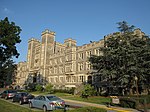Dominican House of Studies
The Dominican House of Studies, located in Washington, DC, houses both the Priory of the Immaculate Conception, a community of the Province of St. Joseph of the Order of Preachers (Dominicans), and the Pontifical Faculty of the Immaculate Conception, an ecclesiastical faculty of theology. It is dedicated to the theological formation of Dominican friars and the service of the church in the Archdiocese of Washington. It serves as a formation community for Dominican candidates for holy orders and the Dominican cooperator brotherhood. It is also the location of the Thomistic Institute and the academic journal The Thomist. The two principal institutions located at the Dominican House of Studies are: The Priory of the Immaculate Conception The Pontifical Faculty of the Immaculate Conception (PFIC), a pontifical, and therefore ecclesiastical, faculty of theology.
Excerpt from the Wikipedia article Dominican House of Studies (License: CC BY-SA 3.0, Authors).Dominican House of Studies
Michigan Avenue Northeast, Washington
Geographical coordinates (GPS) Address External links Nearby Places Show on map
Geographical coordinates (GPS)
| Latitude | Longitude |
|---|---|
| N 38.9317 ° | E -76.9993 ° |
Address
Dominican House of Studies
Michigan Avenue Northeast
20017 Washington
District of Columbia, United States
Open on Google Maps




